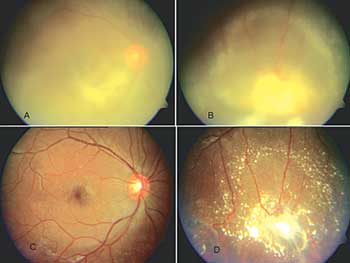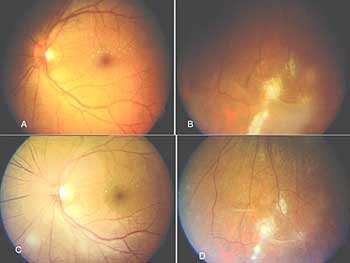Diagnosis and treatment of intraocular tuberculosis challenges physicians
Click Here to Manage Email Alerts
There are roughly 8.7 million reported cases of tuberculosis worldwide, with nearly 3 million deaths attributed to the disease each year, according to the World Health Organization. Tuberculosis, which is seen more frequently in developing countries, generally affects the lungs, but it is capable of affecting extrapulmonary organs as well, including the eyes.
 R.B. Jain |
A lack of definitive diagnostic criteria presents the largest impediment to ophthalmologists looking to treat intraocular tuberculosis, R.B. Jain, MS, MRCOphth, DO, FRCS, said.
“The problem is that there is no clear-cut diagnosis. Many times it is just presumptive. You have to presume that it is the diagnosis, based on clinical appearance, your experience,” Dr. Jain told Ocular Surgery News in a telephone interview. “You cannot really prove in more than one-third of the cases that [the symptoms] are due to intraocular tuberculosis.”
A recent presentation at the All India Ophthalmological Society conference in Bangalore highlighted the ongoing battle against intraocular tuberculosis and sought to remind Indian ophthalmologists of the often subtle and confusing warning signs that accompany it.
Linked with uveitis and multifocal choroiditis
Oftentimes the only way to confirm the existence of intraocular tuberculosis is to use corroborative evidence, usually in the form of a positive tuberculosis test or through awareness of a family history of tuberculosis, Amod Gupta, MBBS, MS, said.
 Amod Gupta |
“With the eye, always there has been a difficulty because … fluids are not available in adequate quantities, a biopsy is not available from the ocular tissue. People in the past have lost eyes in an attempt to do a biopsy to make a [full] diagnosis of intraocular tuberculosis,” Dr. Gupta said.
Physicians should be aware of the possibility of tuberculosis and its ocular implications, especially when a patient presents with symptoms of uveitis or multifocal choroiditis, he said.
These complications, which can be treated locally, will not subside if the root cause is intraocular tuberculosis. If tuberculosis goes untreated, it can lead to frequent unsuccessful visits for the patient, as well as potential loss of the eye. Therefore, Dr. Gupta stressed the need for Indian ophthalmologists to educate themselves regarding intraocular tuberculosis.
Dr. Jain noted the importance of considering tuberculosis when certain inflammatory diseases are present in the eye.
“Once you [have] seen multifocal choroiditis, especially if it is bilateral … in a country like India, where tuberculosis is so common, you have to start thinking of it as [a possible] diagnosis,” Dr. Jain said. “You also think of intraocular tuberculosis in recurrent, bilateral granulomatous iridocyclitis.”
He recounted a recent experience in which a patient was unhappy with the treatment of his symptoms with another ophthalmologist. Upon visiting Dr. Jain, the patient was diagnosed with multifocal choroiditis, which is when Dr. Jain inquired about tuberculosis.
He found that for the past month the patient had been taking care of his brother, who was diagnosed with pulmonary tuberculosis.
The patient tested positive for the disease. According to Dr. Jain, even if the test was negative, he still would have gone forward with treatment for intraocular tuberculosis, using collaborative evidence to diagnose the disease.
|
Images: Gupta V |
Further difficulties
The relationship between specialists can often create difficulties in diagnosis and treatment, according to Vishali Gupta, MD.
 Vishali Gupta |
Because tuberculosis is traditionally viewed as a pulmonary disease, treating it requires ophthalmologists and physicians to work together and agree on a course of systemic treatment. For patients who have latent tuberculosis and ocular complications, the treatment plan can sometimes cause a greater disconnect between ophthalmologists and pulmonologists, Dr. Vishali Gupta said.
Because the disease is widespread in India, the workload makes it impossible to treat every patient with a latent form of tuberculosis, she added.
“If a patient with uveitis has latent tuberculosis that we believe is causing the hypersensitive reaction in the eye and we wish to eliminate the latent infection because … we know that this would help in eliminating the recurrences [in the eye], the chest physician should be convinced about the need to treat this particular patient,” Dr. Vishali Gupta said. “That is why the ophthalmologists would need to know about the disease themselves.”
She also stressed the importance for ophthalmologists to be willing to educate other physicians. Physicians will be looking for the pulmonary effects of tuberculosis when a patient is referred to them but not fully understand the ocular effects. Working as a team may help avoid miscommunication among specialists and ultimately determine the best course of treatment for a specific patient, Dr. Vishali Gupta said.
|
|
Treatment efficacy
This treatment plan typically includes a combination of rifampicin, isoniazid, pyrazinamide and ethambutol. According to Dr. Jain, treatment will be the four drugs for 3 months and followed by rifampicin, isoniazid and pyrazinamide for an additional 6 months.
He has seen several cases in which tuberculosis was suspected clinically, but repeated tests by a physician came back negative, and tuberculosis treatment was not given. After 6 months to 1 year, these patients lost vision in the problematic eye and were developing symptoms in the other eye. Dr. Jain told these patients that if they wanted to save their other eye, they would have to begin treatment for tuberculosis.
“With [these] patients, I have been able to save the eyesight in the other eye on presumptive diagnosis only because there is no confirmative diagnosis,” he said.
Dr. Amod Gupta also noted the success rate of treatment. He said if intraocular tuberculosis is presumed and the patient receives tuberculosis treatment after being presented with inflammatory symptoms such as uveitis or choroiditis, the likelihood of recurrence is low.
“The bottom line being that if you presume the uveitis to be [intraocular] tuberculosis, we need to treat it with a full course of anti-TB drugs. And in our experience, if you give [patients] a full course of anti-TB drugs, along with corticosteroids, [there is] almost an 80% to 85% chance that these uveal inflammations will not recur,” he said.
For more information:
- Amod Gupta, MBBS, MS, and Vishali Gupta, MD, can be reached at the Department of Ophthalmology, Advanced Eye Centre, Postgraduate Institute of Medical Education and Research, Chandigarh-160012, India; +91-172-2747837; fax: +91-172-2747837; e-mail: eyepgi@sify.com.
- R.B. Jain, MS, MRCOphth, DO, FRCS, can be reached at RBM Eye Institute, C-2/1, Prashant Vihar, Delhi 110085, India; +91-11-2756-3939; e-mail: drrbjain@bol.net.in.


